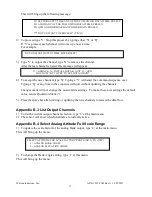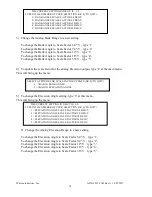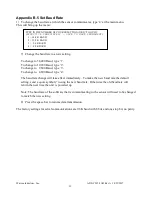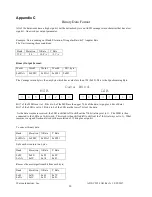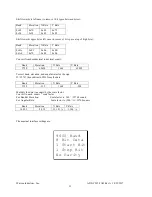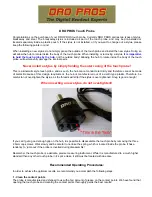
Watson Industries, Inc.
ADS-C232-3AD Rev A 10/25/2017
8
3.
An “F” or “f” will disconnect the references from the attitude system and is the Free Mode
Command. Free mode is used to make the system ignore the references during high
maneuvers and brief disturbances. This mode is not intended for use except in brief
intervals, since errors will grow geometrically. Command mode is not required to access
this function.
4.
A “K” or “k” will clear the Free Mode Command. Command mode is not required to access
this function.
5.
An “!” will reinitialize the unit. Further, access to initialization is inhibited such that a
spacebar command must be sent within about 2 seconds of the “!” command for
initialization to be engaged. Command mode is not required to access this function.
6.
A “Z” or “z” will reset the timer channel counter. The timer channel counts seconds since
the last reset. This command sets the timer back to zero. Command mode is not required to
access this function.
7.
A “L” or “l” will transmit a line of labels corresponding to the data channels that are
currently selected for output. See Appendix A for information about the data channels and
their labels. Command mode is required for access to this command.
8.
An “_” command will change the output format to decimal ASCII. This change is made
non-volatile in the unit on EEPROM by keying in the quote (“) character. Command mode
is required for access to this command.
9.
A “^” command will change the output format to binary. This change is made non-volatile
in the unit on EEPROM by keying in the quote (“) character. Command mode is required
for access to this command.
10.
A “:” command will toggle the output to send a frame of data upon receiving any non-
command character (On to Off; Off to On). This change is made non-volatile in the unit on
EEPROM by keying in the quote (“) character. Command mode is required for access to
this command.
Note: To test if this command is active when the unit is not flowing data, send a carriage
return (or any other non-command character to the sensor, and observe if there is any
output.
11.
A “+” command will suppress or restore the transmission of data. This command will
toggle the data transmission (On to Off; Off to On). Command mode is required for access
to this command.
Note: It is possible for both the “:” and the “+” commands to be active at the same time.
The “+” command determines whether the sensor is allowed to transmit data. So if this were
the case, the “:” command must also be turned off to allow the free flow of data.
12.
An “*” command will suppress or restore the initialization message in the Decimal ASCII
mode. This command will toggle the transmitting of the text header during initialization
(On to Off; Off to On). This change is made non-volatile in the unit on EEPROM by keying
in the quote (“) character. Command mode is required for access to this command.

















